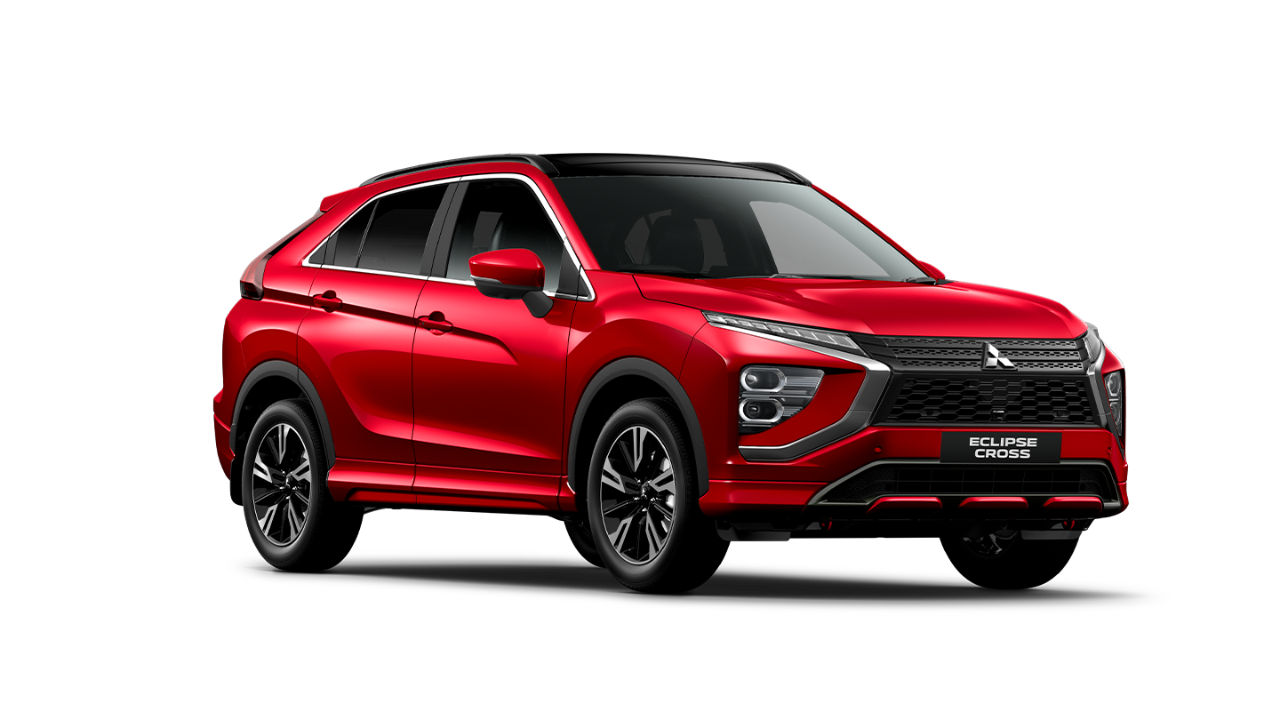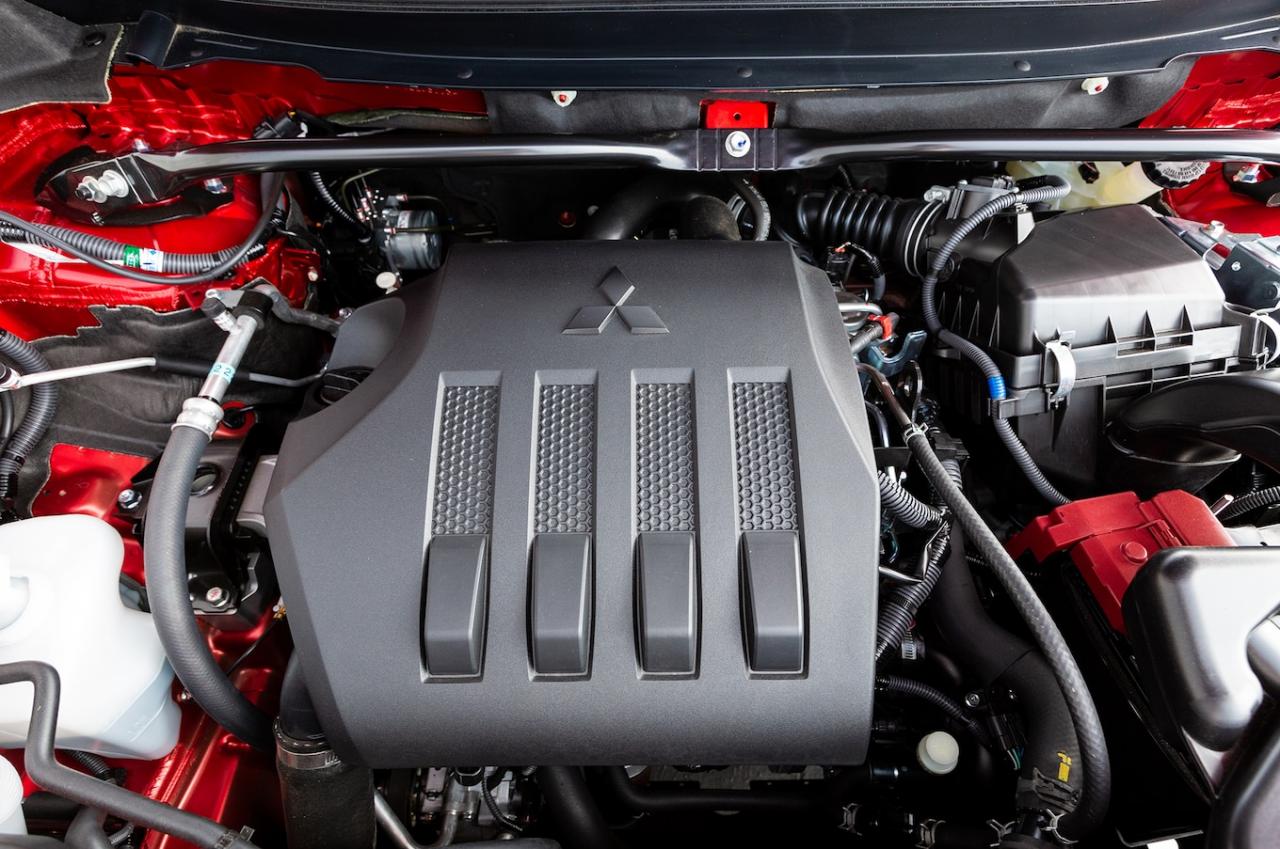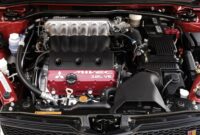Mitsubishi Eclipse Cross engine problems and solutions: Facing engine trouble with your sleek Eclipse Cross? Don’t panic! This deep dive explores common engine woes, from oil leaks to cooling system hiccups, offering practical solutions and preventative maintenance tips. We’ll uncover the root causes of those pesky engine warning lights, guiding you through troubleshooting steps and helping you get back on the road smoothly.
Prepare for a comprehensive guide that’ll transform you from worried owner to confident car enthusiast.
This guide covers everything from identifying the top three most frequent engine issues and their symptoms to understanding the importance of regular oil changes and the role of the cooling system. We’ll detail solutions for each problem, including preventative measures and how to interpret those dreaded engine warning lights. We’ll even tackle fuel system problems and performance issues, providing step-by-step troubleshooting guides and maintenance advice to keep your Eclipse Cross running like a dream.
Get ready to become a pro at maintaining your Mitsubishi Eclipse Cross!
Common Mitsubishi Eclipse Cross Engine Problems
The Mitsubishi Eclipse Cross, while offering a stylish design and competitive features, isn’t immune to engine-related issues. Understanding these common problems can help owners proactively address potential concerns and ensure the longevity of their vehicle. This section details three frequently reported engine problems, their symptoms, causes, and estimated repair costs.
Engine Oil Consumption
Excessive engine oil consumption is a recurring complaint among Eclipse Cross owners. This issue manifests in several ways, impacting both vehicle performance and long-term engine health.Symptoms associated with high oil consumption include the need to frequently top off the oil between scheduled changes, a noticeable decrease in oil level on the dipstick, and potentially even a warning light illuminating on the dashboard indicating low oil pressure.
In severe cases, blue smoke may be visible from the exhaust, indicating that oil is burning in the combustion chamber.The underlying cause of this problem can vary. Common culprits include worn piston rings, damaged valve stem seals, or a faulty PCV (positive crankcase ventilation) system. Worn piston rings allow oil to seep into the combustion chamber, while damaged valve stem seals permit oil to leak past the valves.
A malfunctioning PCV system can also lead to increased oil consumption by not properly venting crankcase pressure.
Engine Misfires
Another common issue is engine misfires, resulting in rough idling, hesitation during acceleration, and a reduction in fuel efficiency. These misfires can stem from several sources, each requiring a different approach to repair.Symptoms of engine misfires include a rough or uneven idle, a noticeable shaking or vibration in the engine compartment, a loss of power or hesitation when accelerating, and a check engine light illuminated on the dashboard, often accompanied by a diagnostic trouble code (DTC) related to misfires.Causes of engine misfires are multifaceted.
They can range from faulty spark plugs or ignition coils to issues with the fuel injectors or even problems within the engine’s computer system (ECM). A failing oxygen sensor can also contribute to misfires by providing inaccurate information to the engine control unit, leading to improper fuel delivery.
Turbocharger Problems
The turbocharged engines in some Eclipse Cross models can experience turbocharger-related issues, leading to performance loss and potential engine damage if left unaddressed.Symptoms might include a noticeable loss of power, a whistling or hissing sound emanating from the engine bay, and a noticeable decrease in fuel efficiency. In more severe cases, the turbocharger may fail completely, leading to a complete loss of power.Turbocharger problems often stem from a lack of proper lubrication, leading to premature wear and tear on the turbocharger bearings.
This can be caused by infrequent oil changes, the use of low-quality oil, or a blocked oil line to the turbocharger. Additionally, excessive engine heat or debris entering the turbocharger can also cause damage.
Facing Mitsubishi Eclipse Cross engine troubles? Common issues include faulty fuel injectors and timing chain problems, requiring professional diagnosis and repair. Before you hit the road for repairs, however, you might wonder about passenger capacity; check out this helpful guide on How Many People Can Fit In A Mitsubishi? to see how many can comfortably join you on your next trip.
Getting your Eclipse Cross back in tip-top shape will ensure plenty of space for everyone!
| Problem | Symptoms | Cause | Estimated Repair Cost |
|---|---|---|---|
| Engine Oil Consumption | Frequent oil topping off, low oil level, blue exhaust smoke | Worn piston rings, damaged valve stem seals, faulty PCV system | $500 – $2000+ |
| Engine Misfires | Rough idle, shaking, loss of power, check engine light | Faulty spark plugs, ignition coils, fuel injectors, oxygen sensor, ECM issues | $200 – $1500+ |
| Turbocharger Problems | Loss of power, whistling sound, reduced fuel efficiency | Lack of lubrication, excessive heat, debris | $1000 – $3000+ |
Engine Oil Related Issues: Mitsubishi Eclipse Cross Engine Problems And Solutions
Maintaining the correct engine oil level and using the appropriate viscosity are crucial for the longevity and performance of your Mitsubishi Eclipse Cross engine. Neglecting these aspects can lead to significant and costly repairs down the line. Ignoring oil-related issues can result in decreased engine efficiency, reduced fuel economy, and ultimately, catastrophic engine failure.Using the incorrect engine oil viscosity can severely impact your engine’s performance and lifespan.
The viscosity, or thickness, of the oil is critical for proper lubrication. Too thick an oil hinders proper flow, leading to increased friction and heat, potentially causing damage to engine components. Conversely, oil that’s too thin won’t provide adequate protection against wear and tear, resulting in accelerated engine wear and potential scoring of engine parts. The owner’s manual clearly specifies the recommended viscosity grade for your specific Eclipse Cross model and operating conditions; deviating from this recommendation is strongly discouraged.
For example, using a 5W-30 oil when a 10W-40 is specified could lead to increased engine wear during hotter operating temperatures.
Consequences of Incorrect Engine Oil Viscosity
Using the wrong viscosity engine oil can lead to a range of problems, from reduced fuel efficiency to complete engine seizure. Thicker-than-recommended oil can increase engine friction, leading to higher operating temperatures and potentially damaging engine components like bearings and seals. This increased friction also translates to reduced fuel efficiency as the engine has to work harder. Conversely, thinner oil might not provide sufficient lubrication at higher temperatures or under heavy load, resulting in increased wear and potential engine damage.
This could manifest as noisy engine operation, reduced power, or even catastrophic engine failure. Sticking to the manufacturer’s recommended viscosity is paramount to avoid these issues.
Facing Mitsubishi Eclipse Cross engine troubles? Solutions range from simple maintenance checks to more involved repairs. But hey, even with potential engine issues, you can still enjoy the ultimate comfort features; check out how to Stay Cozy With Mitsubishi’s heated seats for those chilly drives. Getting back to the Eclipse Cross, remember regular servicing is key to preventing major engine problems down the line.
Importance of Regular Oil Changes
Regular oil changes are non-negotiable for maintaining the health of your Mitsubishi Eclipse Cross engine. Engine oil degrades over time, accumulating contaminants like dirt, soot, and metal particles. These contaminants can increase friction, reduce lubrication effectiveness, and accelerate engine wear. Following the recommended oil change intervals specified in your owner’s manual is vital. Ignoring these intervals can drastically shorten the life of your engine, leading to premature wear and costly repairs.
For instance, failing to change the oil every 5,000 miles (or the manufacturer’s recommended interval) can lead to sludge buildup, which can clog oil passages and starve the engine of vital lubrication.
Checking Engine Oil Level and Condition
Checking your engine oil level and condition is a simple yet crucial maintenance task. First, ensure your engine is completely cool and parked on a level surface. Locate the engine oil dipstick, usually marked with a distinctive handle. Remove the dipstick, wipe it clean with a lint-free cloth, reinsert it fully, and remove it again. The oil level should fall between the minimum and maximum marks on the dipstick.
If the level is low, add the correct type and amount of oil as specified in your owner’s manual. Additionally, inspect the oil’s condition. Fresh oil should be clear or slightly amber; dark, dirty oil indicates the need for an immediate change. If the oil is milky or frothy, it could indicate a head gasket leak, requiring immediate professional attention.
Preventative Maintenance Tips to Minimize Oil-Related Engine Issues
Several preventative measures can significantly reduce the risk of oil-related engine problems. Always use the correct type and viscosity of engine oil as specified in your owner’s manual. Adhere to the recommended oil change intervals, and don’t hesitate to change the oil more frequently if you regularly drive in harsh conditions, such as extreme heat or towing heavy loads.
Regularly check your oil level, and address any leaks promptly. Consider using a high-quality oil filter to ensure effective contaminant removal. Finally, be sure to have a professional mechanic inspect your engine regularly to identify and address potential problems before they escalate into major repairs.
Engine Cooling System Problems
Keeping your Mitsubishi Eclipse Cross’s engine cool is crucial for its longevity and performance. A malfunctioning cooling system can lead to catastrophic engine damage, so understanding its components and potential issues is vital for any owner. This section details common problems within the Eclipse Cross’s cooling system, their symptoms, and how to troubleshoot them.
Cooling System Components and Their Functions
The Eclipse Cross’s engine cooling system works to regulate engine temperature, preventing overheating and ensuring optimal performance. Key components include the radiator, water pump, thermostat, and coolant. The radiator dissipates heat from the coolant, the water pump circulates the coolant, the thermostat regulates coolant flow, and the coolant itself absorbs and transfers heat. A failure in any of these components can disrupt the entire system’s efficiency.
For example, a faulty water pump can prevent coolant circulation, leading to overheating, while a malfunctioning thermostat can either restrict or allow excessive coolant flow, both detrimental to engine health.
Radiator Problems
Radiator issues often manifest as leaks, clogging, or damage to the fins. Leaks can be caused by corrosion, damage from debris, or manufacturing defects. Clogging is usually due to accumulated debris or sediment within the radiator’s internal passages. Damaged fins reduce the radiator’s surface area, hindering its ability to dissipate heat. Symptoms can include coolant leaks, overheating, and reduced cooling efficiency, potentially leading to engine overheating warnings.
Regular inspections and cleaning are crucial preventative measures. A visual inspection can often reveal leaks or damage.
Water Pump Problems
The water pump, driven by the engine’s belt, is responsible for circulating coolant throughout the system. A failing water pump might exhibit a whining or grinding noise, indicating bearing wear. Leaks may also occur due to seal failure. The most significant symptom is a complete lack of coolant circulation, resulting in rapid overheating and potential engine seizure.
Regular belt and pulley inspections are important for early detection.
Thermostat Problems
The thermostat controls coolant flow to the radiator. A stuck-open thermostat allows coolant to constantly circulate, potentially leading to the engine running too cold and reduced efficiency. Conversely, a stuck-closed thermostat prevents coolant from reaching the radiator, causing rapid overheating. Symptoms include inconsistent engine temperature readings, either consistently low or high, and potentially overheating warnings. Testing the thermostat by checking its opening temperature in boiling water can help determine its functionality.
Coolant Problems
Insufficient coolant levels or contaminated coolant can severely impact the cooling system’s effectiveness. Low coolant levels can lead to overheating, while contaminated coolant, such as coolant mixed with oil, indicates a serious leak or internal engine damage. A visible leak under the car or a consistently low coolant level are clear indicators. Overheating is a major symptom, often accompanied by steam or visible coolant loss.
Troubleshooting Cooling System Problems Flowchart, Mitsubishi Eclipse Cross engine problems and solutions
The following flowchart provides a systematic approach to diagnosing cooling system problems:
1. Check Coolant Level
Is the coolant level low? Yes -> Investigate leaks; No -> Proceed to step
2. 2. Check for Leaks
Are there any visible leaks in the radiator, hoses, or water pump? Yes -> Repair leaks; No -> Proceed to step
3. 3. Check Engine Temperature
Is the engine overheating? Yes -> Check thermostat and water pump; No -> Proceed to step
4. 4. Check Radiator
Is the radiator clogged or damaged? Yes -> Clean or replace radiator; No -> Check thermostat function.
5. Check Thermostat
Is the thermostat stuck open or closed? Yes -> Replace thermostat; No -> Check water pump.
6. Check Water Pump
Is the water pump functioning correctly (no unusual noises or leaks)? Yes -> Further investigation needed; No -> Replace water pump.
Solutions and Preventative Measures
Addressing engine problems in your Mitsubishi Eclipse Cross requires a multifaceted approach combining effective solutions with proactive preventative maintenance. Ignoring warning signs can lead to costly repairs down the line, so understanding both reactive and preventative strategies is crucial for maintaining your vehicle’s longevity and performance. This section Artikels solutions for common engine issues and details preventative measures to minimize future problems.
Engine Oil Related Issue Solutions
Proper oil maintenance is paramount for engine health. Neglecting this can lead to significant damage. The following solutions address common oil-related problems:
- Low Oil Level: Immediately add the correct type and amount of engine oil as specified in your owner’s manual. Frequent low oil levels indicate a leak; professional inspection is necessary to locate and repair the leak.
- Oil Leaks: Repairing oil leaks requires identifying the source (e.g., gasket, seal, oil pan). This often involves professional mechanical expertise and may require replacing damaged components.
- Incorrect Oil Type: Using the wrong oil viscosity can reduce engine performance and lead to premature wear. Drain the incorrect oil and replace it with the correct type and viscosity specified in your owner’s manual.
- Oil Sludge: This is often caused by infrequent oil changes or using the wrong oil. A professional engine flush might be necessary to remove sludge buildup. Subsequently, ensure regular oil changes using the recommended oil type and filter.
Engine Cooling System Problem Solutions
A malfunctioning cooling system can lead to overheating and catastrophic engine damage. Addressing these issues promptly is vital.
- Overheating: If your engine overheats, pull over immediately to a safe location and turn off the engine. Allow the engine to cool before attempting to diagnose the problem. Potential causes include low coolant levels, a faulty thermostat, a failing water pump, or a clogged radiator. Professional diagnosis is recommended.
- Low Coolant Level: Check the coolant level in the reservoir. If low, add the correct type of coolant (check your owner’s manual). Frequent low coolant levels suggest a leak; a mechanic should inspect for leaks in hoses, the radiator, or the water pump.
- Faulty Thermostat: A malfunctioning thermostat can prevent the engine from reaching optimal operating temperature or cause overheating. Replacement is usually necessary, and this should be done by a qualified mechanic.
- Water Pump Failure: A failing water pump will impede coolant circulation, leading to overheating. Replacement is necessary, requiring professional assistance.
Preventative Maintenance Strategies
Regular preventative maintenance is the best way to avoid many engine problems.
- Regular Oil Changes: Follow the recommended oil change intervals in your owner’s manual. Using high-quality oil and filter is crucial.
- Coolant System Flush: Flush and refill your cooling system every few years (consult your owner’s manual for the recommended interval) to remove contaminants and prevent corrosion.
- Regular Inspections: Regularly check fluid levels (oil, coolant, power steering fluid, brake fluid), belts, and hoses for wear and tear. Address any issues promptly.
- Professional Servicing: Schedule regular professional servicing according to your owner’s manual. This often includes inspections and preventative maintenance tasks that you might miss.
Interpreting Engine Warning Lights
Engine warning lights are crucial indicators of potential problems.
Different warning lights indicate different issues. For example, a check engine light could signal a variety of problems, from a loose gas cap to a serious engine malfunction. A flashing check engine light usually indicates a more severe problem requiring immediate attention. Consult your owner’s manual for a description of each warning light and take your vehicle to a mechanic for diagnosis if a warning light illuminates.
Ignoring warning lights can lead to significant damage and costly repairs.
Fuel System Problems and Solutions

The fuel system in your Mitsubishi Eclipse Cross, like any other vehicle, is crucial for engine operation. A malfunctioning fuel system can lead to frustrating driving experiences, ranging from poor performance to complete engine failure. Understanding potential problems and their solutions is key to maintaining your vehicle’s reliability and longevity. This section will explore common fuel system issues, their symptoms, and troubleshooting steps.
Fuel Pump Malfunctions
A failing fuel pump can significantly impact engine performance. The fuel pump’s responsibility is to deliver fuel from the tank to the engine at the required pressure. Symptoms of a failing fuel pump include difficulty starting the engine, sputtering or hesitation during acceleration, and a noticeable decrease in fuel efficiency. In severe cases, the engine might completely fail to start.
Troubleshooting involves checking fuel pressure using a pressure gauge. Low fuel pressure directly points to a failing fuel pump, often requiring replacement. Regular maintenance, including avoiding running the tank on empty, can help prolong the life of the fuel pump.
Fuel Injector Issues
Fuel injectors precisely meter fuel into the engine’s combustion chambers. Clogged or faulty injectors can lead to rough idling, misfires, reduced engine power, and increased emissions. Symptoms often include a rough running engine, particularly at idle, poor acceleration, and a noticeable decrease in fuel economy. Diagnosing injector problems often requires specialized tools like a fuel injector cleaner or a diagnostic scan tool to check for misfire codes.
Cleaning or replacing faulty injectors is typically the solution. Using high-quality fuel can help prevent injector clogging.
Fuel Filter Problems
The fuel filter removes contaminants from the fuel before it reaches the engine. A clogged fuel filter restricts fuel flow, leading to similar symptoms as a failing fuel pump or injectors. Symptoms include difficulty starting, poor acceleration, and reduced fuel efficiency. A clogged filter is often easy to identify by inspecting it visually – a dark, dirty filter indicates the need for replacement.
Fuel Filter Replacement Procedure
Replacing the fuel filter is a relatively straightforward procedure, though safety precautions are essential. Before starting, always consult your vehicle’s owner’s manual for specific instructions and locations.
- Safety First: Disconnect the negative battery terminal to prevent electrical shocks. Fuel is highly flammable; work in a well-ventilated area away from open flames.
- Locate the Fuel Filter: The fuel filter’s location varies depending on the model year. Consult your owner’s manual for its precise location.
- Prepare for Replacement: Gather the necessary tools: new fuel filter, wrench (size may vary), rags, and a container to catch spilled fuel.
- Release Fuel Pressure: To relieve pressure in the fuel lines, carefully follow the instructions in your owner’s manual. This is a crucial step to prevent fuel spillage and injury.
- Disconnect Fuel Lines: Carefully disconnect the fuel lines from the old filter, using rags to absorb any spilled fuel. Note the orientation of the lines to ensure correct reconnection.
- Remove the Old Filter: Unscrew the old fuel filter using the appropriate wrench.
- Install the New Filter: Carefully install the new fuel filter, ensuring it is correctly oriented. Tighten securely using the wrench.
- Reconnect Fuel Lines: Reconnect the fuel lines to the new filter, ensuring a tight and secure connection.
- Reconnect Battery Terminal: Reconnect the negative battery terminal.
- Check for Leaks: Inspect the connections for any leaks. If leaks are present, carefully tighten the connections.
- Start the Engine: Start the engine and check for any unusual sounds or performance issues.
Engine Performance Issues
Experiencing a drop in your Mitsubishi Eclipse Cross’s engine performance can be frustrating. This section delves into the common causes of decreased engine power, rough idling, and other performance-related issues, providing diagnostic strategies and effective solutions to restore your vehicle’s optimal performance. Understanding these problems and implementing preventative measures is key to maintaining a reliable and efficient engine.Decreased engine performance in the Eclipse Cross, manifesting as sluggish acceleration, rough idling, or a lack of power, can stem from several sources.
These often interrelate, making thorough diagnosis crucial. Ignoring these symptoms can lead to more significant and costly repairs down the line.
Causes of Decreased Engine Performance
Several factors can contribute to a decline in engine performance. These range from relatively minor issues easily resolved with routine maintenance to more serious problems requiring professional attention. Identifying the root cause is the first step towards a solution. For example, a clogged air filter restricts airflow to the engine, reducing power. Similarly, worn spark plugs can cause misfires, leading to rough idling and poor acceleration.
A failing mass airflow sensor (MAF) provides inaccurate readings to the engine control unit (ECU), resulting in a fuel delivery imbalance and reduced performance. Low compression in one or more cylinders can also drastically impact engine power output.
Diagnosing Engine Performance Issues
Diagnosing the exact cause of decreased engine performance requires a systematic approach. Starting with a visual inspection of components like the air filter, spark plugs, and belts can reveal obvious problems. Checking engine codes using an OBD-II scanner provides valuable clues, as these codes often point to specific sensor or system malfunctions. Further diagnostics might involve compression testing to assess the health of the cylinders, a fuel pressure test to check fuel delivery, and a thorough inspection of the ignition system.
A professional mechanic can perform these tests accurately and efficiently. Ignoring warning lights or delaying professional assessment can lead to more extensive and costly damage.
Solutions for Restoring Optimal Engine Performance
Solutions vary depending on the identified problem. A simple fix might involve replacing a worn air filter or spark plugs. More complex issues, such as a faulty MAF sensor or low compression, require professional repair. In cases of low compression, it might indicate worn piston rings, valves, or head gasket issues—problems demanding significant mechanical intervention. Regular maintenance, as detailed below, plays a vital role in preventing many of these issues.
Remember, attempting complex repairs without proper knowledge and tools can cause further damage and potentially void warranties.
Maintaining Optimal Engine Performance
Regular maintenance is crucial for preventing engine performance issues and ensuring the longevity of your Eclipse Cross’s engine. This includes timely oil changes using the recommended oil type and viscosity, replacing the air filter according to the manufacturer’s schedule, and inspecting and replacing spark plugs as needed. Regularly checking and topping off fluids such as coolant and power steering fluid is also essential.
Following the manufacturer’s recommended maintenance schedule detailed in your owner’s manual is the best way to keep your engine running smoothly and efficiently. Ignoring these preventative steps can lead to premature wear and tear, resulting in costly repairs down the line. Proactive maintenance is far cheaper and less disruptive than reactive repairs.
Visual Representation of Engine Components

Understanding the layout and function of your Mitsubishi Eclipse Cross engine’s key components is crucial for preventative maintenance and troubleshooting. A visual representation, even a mental one, helps you quickly identify potential problem areas. This section provides a detailed description of a typical Eclipse Cross engine, focusing on key components and their roles.Imagine the engine block, a large, sturdy metal casting, forming the heart of the system.
This houses the cylinders where the pistons move up and down, creating power. The block is typically dark grey or black, with various bolt heads and threaded holes visible. Its rough, cast-metal texture is apparent. Connected to the block is the cylinder head, a more intricate component with smaller passages and ports for coolant and air.
The cylinder head is usually made of aluminum alloy, lighter in weight and often featuring a smoother surface than the block. Its upper surface will have various openings for spark plugs, valve covers, and other components.
Spark Plugs
Spark plugs are small, cylindrical components screwed into the cylinder head. Each plug has a central electrode surrounded by a grounded electrode. They are responsible for igniting the air-fuel mixture within the combustion chamber, initiating the power stroke. Their appearance is usually porcelain-white or light beige, with a metal threaded base. They are crucial for proper engine combustion and should be inspected and replaced regularly according to the maintenance schedule.
Damaged or worn spark plugs can lead to misfires and reduced engine performance.
Timing Belt/Chain
The timing belt (or chain, depending on the specific Eclipse Cross engine) is a critical component responsible for synchronizing the rotation of the crankshaft and camshaft. The belt is typically a rubberized material with teeth that mesh with sprockets on both shafts. A timing chain, on the other hand, is a metal chain that serves the same function.
Both are located on the front of the engine, often covered by a plastic shroud. Failure of the timing belt/chain can cause catastrophic engine damage, highlighting the importance of regular inspection and replacement as recommended in the owner’s manual.
Hoses and Belts
Numerous hoses and belts crisscross the engine bay. Hoses, typically made of rubber or reinforced silicone, carry coolant through the cooling system, while belts drive various accessories like the alternator, power steering pump, and air conditioning compressor. These components vary in color and diameter, with hoses generally being black or dark colored, and belts exhibiting a ribbed texture.
Their condition should be regularly checked for cracks, wear, or leaks, as deterioration can lead to overheating, loss of power steering, or malfunctioning accessories.


